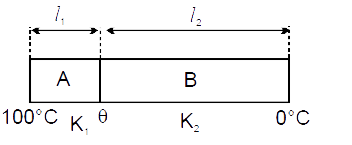A copper strip AB and an iron strip AC are joined at A. The junction A is maintained at 0∘C and the free ends BandC are maintained at 100∘C. There is a potential difference between
the two ends of the copper strip
the copper end and the iron end at the junction
the two ends of the iron strip
the free ends BandC.
The correct Answer is:A, B, C, D
Step by step video, text & image solution for A copper strip AB and an iron strip AC are joined at A. The junction A is maintained at 0^@ C and the free ends B and C are maintained at 100^@ C. There is a potential difference between by Physics experts to help you in doubts & scoring excellent marks in Class 12 exams.
Updated on:21/07/2023Topper's Solved these Questions
- THERMAL AND CHEMICAL EFFECT OF ELECTRIC CURRENTBOOK - HC VERMACHAPTER - THERMAL AND CHEMICAL EFFECT OF ELECTRIC CURRENTEXERCISE - Exercises
24 Videos
- THERMAL AND CHEMICAL EFFECT OF ELECTRIC CURRENTBOOK - HC VERMACHAPTER - THERMAL AND CHEMICAL EFFECT OF ELECTRIC CURRENTEXERCISE - Objective 1
8 Videos
- THE SPECIAL THEORY OF RELATIVITYBOOK - HC VERMACHAPTER - THE SPECIAL THEORY OF RELATIVITYEXERCISE - Exercise
1 Videos
- X-RaysBOOK - HC VERMACHAPTER - X-RaysEXERCISE - Exercises
27 Videos
Similar Questions
Two rods A and B of different materials but same cross section are joined as in figure. The free end of A is maintained at 100°C and the free end of B is maintained at 0°C. If l2=2l1,K1=2K2 and rods are thermally insulated from sides to prevent heat loses then the temperature θ of the junction of the two rods is

View SolutionFigure shows an aluminium rod joined to a copper rod. Each of the rods has a length of 20cm and area of ccross section 0.20cm2 . The junction is maintained at a constant temperature 40∘C and the two ends are maintained at 80^(@)C.Calca––tetheamountofheattakenoutomthecoldjunction∈o≠minuteafterthesteadystateisreached.TheconductivitiesareK_(Al)=200Wm^(-1)^(∘)C−1 . and KCu=400Wm−1^(@)C^(-1) .

View Solution
Knowledge Check
The charcoal maintained at 100∘C absorbs
ANe and KrBHe and ArCAr, Kr and XeDHe and NeThe charcoal maintained at−100∘C absorbs
ANe and KrBHe and ArCAr, Kr and XeDHe and NeThe end A of rod AB of length 1 m is maintained at 80∘C and the end B at 0∘C. The temperature at a distance of 60 cm from the end A is
A16∘CB32∘CC48∘CD64∘C
Two rods of material, x and two of y are connected as shown in the figure. All the rods are indentical in length and cross-sectional area. If the end A is maintained at 80∘C and the end D is maintained at 10∘C, calculate the temperature of the junctions B and C in the steady state. Thermal conductivity of x is double that of y.

View SolutionThree bars of aluminium, brass and copper are of equal length and cross section. The three pieces are joined together as shown in A, B and C and the ends are maintained at 100∘C and 0∘C. The thermal conductivities of aluminium, brass and copper are in ratio 2 : 1 : 4. Assume no heat loss through curved surface of the bar and that the system is in steady state.
(a) In which of the three cases (A, B or C) the temperature difference across aluminium bar will be maximum?
(b) Draw a graph showing variation of temperature from one end of the bar to another in case B.
View SolutionA rod AB is 1m long. The temperature of its one end A is maintained at 100∘C and other end B at 10∘C, the temperature at a distance of 60 cm from point B is
View SolutionMetal rods X and Y of identical cross-sectional area, have lengths 60 cm and 30 cm respectively. They are made of metals of thermal conductivities λx and λy. They are well-lagged and joined end-to-end as shown in the figure-4.43. One end of X is maintained at 100∘C and the opposite end of Y is maintained at 0∘C. When steady conditions have been .reached, the temperature of the junction is found to be 25∘C.
What is the value of λxλy ?

View SolutionOne end of conducting rod is maintained at temperature 50∘C and at the other end ice is melting at 0∘C. The rate of melting of ice is doubled if:
View Solution
